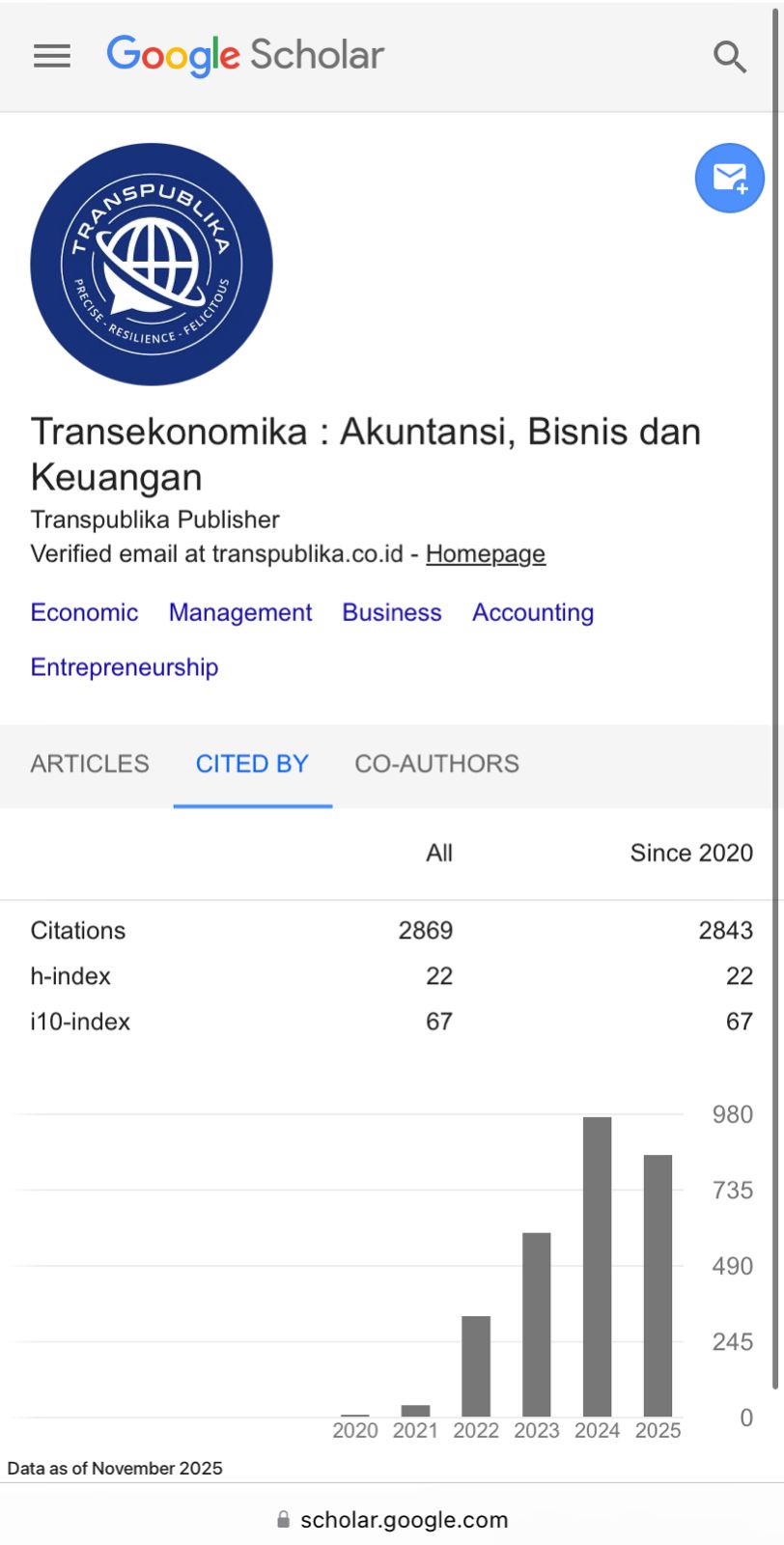ANALISIS FAKTOR-FAKTOR YANG MEMPENGARUHI UTANG LUAR NEGERI INDONESIA PERIODE 1985-2020
Abstract
Indonesia is one of the developing countries in the Asian continent that uses foreign debt as aid to support the country's economic development, resulting in an increase in Indonesia's foreign debt every year. On the other hand, increasing foreign/external debt is one of the economic problems caused by world economic shocks or when an economic recession is occurring. This study aims to determine the relationship between the variabels of the level of exports, imports, and inflation rates on Indonesia's external debt. The analysis technique used is the Vector Error Correction Model (VECM) with a research period from 1985 to 2020 and using the E-Views 10 application. The test results show that the variabels of exports, imports, and inflation have a significant relationship with external debt in the long term. While the relationship in the short term shows a less significant relationship between these variabels.
Downloads
References
Arfah, W. (2016). Analisis determinan utang luar negeri indonesia. Skripsi.
Atmadja, A. S. (2020). Utang Luar Negeri Pemerintah Indonesia : Perkembangan Dan Dampaknya. Jurnal Akuntansi dan Keuangan, 2(1), 83–94.
Cahyani, A. R. N., & Priyono, N. (2022). Analysis of Degrees of Regional Original Income Decentralization and Independence and The Relationship with Regional Expenditure Productivity in Magelang Regency 2016-2020. Marginal: Journal Of Management, Accounting, General Finance And International Economic Issues, 1(2), 1–10.
Cahyani, Y. T. (2018). Pengaruh Inflasi, Suku Bunga (BI Rate), Produk Domestik Bruto (PDB) Terhadap ROA (Studi Pada Bank Pembiayaan Rakyat Syariah (BPRS) di Indonesia Tahun 2009-2016). Ekonomi, Jurnal Inflasi, Pengaruh Bunga, Suku Rate, B I Pada, Studi Pembiayaan, Bank Syariah, Rakyat Tahun, Indonesia, 5(1).
Desi, A., & Eddy, G. (2016). Pengaruh Produksi Beras, Harga Beras Dalam Negeri Dan Produk Domestik Bruto Terhadap Impor Beras Indonesia. 1(2), 455–466.
Fadillah, A. N. D. N., & Sutjipto, H. (2018). Analisis Faktor-Faktor Yang Mempengaruhi Utang Luar Negeri Indonesia. Jurnal Ekonomi-Qu, 8(2), 212–226. https://doi.org/10.35448/jequ.v8i2.4449
Handayani, S. F. (2020). Jurnal Indonesia Sosial Sains. Jurnal Indonesia Sosial Sains, 1(September), 132–141.
Harjanto, T. (2015). Hutang Luar Negeri Indonesia Antara Kebutuhan dan Beban Rakyat. Jurnal Ekonomi ISSN, 2302-7169.
Hutapea, F. D., & Ardianto. (2020). engaruh Penyisihan Pencadangan Aset, Kualitas Kredit, Dewan Komisaris, Komite Audit, Ukuran Dan Kualitas Auditor Terhadap Manajemen Laba. Jurnal Ekonomi dan Bisnis Airlangga, 30(1), 14–28. https://doi.org/10.20473/jeba.V30I12020.6246
Khair, M., & Rusydi, B. U. (2016). Analisis Pengaruh Utang Luar Negeri (Foreign Debt) Dan Penanaman Modal Asing (Pma) Terhadap Nilai Produk Domestik Bruto (Pdb) Indonesia. Economics, Sosial, and Development, 3(1), 82–100.
Kuswantoro, M. (2017). Analisis Pengaruh Inflasi, Kurs, Utang Luar Negeri Dan Ekspor Terhadap Cadangan Devisa Indonesia. Tirtayasa Ekonomika, 12(1), 146. https://doi.org/10.35448/jte.v12i1.4442
Manappo, V. (2007). Utang Luar Negeri Indonesia. E-Journal Perdagangan Industri dan Moneter Vol. 7. No. 3, September– Desember 2019 ISSN: 2303-1204 (online), 7, 68–70.
Meisyani, I. (2021). Pengaruh Inflasi, Nilai Tukar, Dan Suku Bunga Terhadap Utang Luar Negeri Pemerintah Indonesia. Skripsi.
Ristuningsih, S. (2016). Analisis faktor-faktor yang mempengaruhi utang luar negeri indonesia periode (1984-2013). Katadata, http://databoks.katadata.co.id/datapublish/2016/08.
Sadono, S. (2012). Ekonomi Makro Teori Pengantar. Rajawali Pers.
Saputra, D., Aimon, H., & Adry, M. R. (2019). Analisis Faktor-Faktor Yang Mempengaruhi Utang Luar Negeri Di Indonesia. Jurnal Ecogen, 1(3), 482. https://doi.org/10.24036/jmpe.v1i3.4989
Sari, M. (2016). Penyebab Utang Luar Negeri Indonesia. 1–20.
Sulistiana, I. (2017). Model Vector Auto Regression ( VAR ) and Vector Error Correction Model ( VECM ) Approach for Inflation Relations Analysis , Gross Regional Domestic Product ( GDP ), World Tin Price , Bi Rate and Rupiah Exchange Rate. 17–32.
Todaro, M. P., & Smith, S. C. (2014). Human Capital: Education and Health in Economic Development-in Economic Development. (Tehran (ed.)).
Ulfa, S., & Zulham, T. (2017). Analisis Utang Luar Negeri Dan Pertumbuhan Ekonomi: Kajian Faktor-Faktor Yang Mempengaruhinya. 2(1), 144–152.
Vinny, F. S. (2019). Analisis Faktor-Faktor Yang Mempengaruhi Utang Luar Negeri Di Indonesia Skripsi.
Wulandari, R., Sugianto, S., & Aminda, R. S. (2022). Analisis Faktor-Faktor Yang Mempengaruhi Utang Luar Negeri Di Indonesia. Jurnal Indonesia Sosial Sains, 3(Universitas Pembangunan Nasional Veteran Jakarta).
Yuniarti, D. (2005). Uji Kausalitas : Utang Luar Negeri Dan Capital Flight Di Indonesia, 1974-2002. Economic Journal of Emerging Markets, 10(3), 265–273.
Copyright (c) 2022 Mukhamad Yusuf Iskandar

This work is licensed under a Creative Commons Attribution 4.0 International License.








.png)







.png)


.png)

.png)















